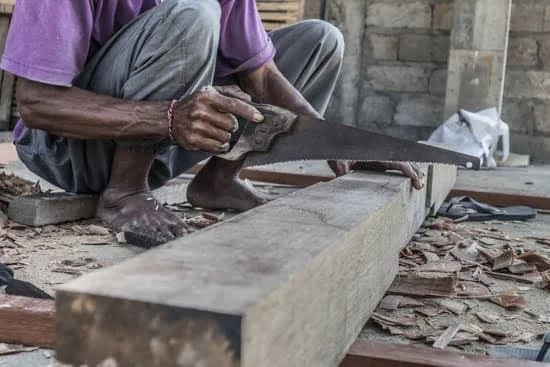Woodworking glue is an essential component in any woodworking project, playing a critical role in creating durable and long-lasting bonds between wood pieces. The key to a successful woodworking project lies in using the best woodworking glue available. Whether you are a seasoned woodworker or just starting out, understanding the various types of woodworking glues and their proper application is crucial for achieving professional results.
In this article, we will delve into the world of woodworking glue, exploring the different types such as PVA glue, polyurethane glue, epoxy, and cyanoacrylate. We will also discuss the important factors to consider when choosing the right woodworking glue for your specific project, including temperature resistance, drying time, water resistance, and strength.
Furthermore, we will provide a comprehensive review of the top 5 best woodworking glues currently available in the market along with their key features. Additionally, we will offer step-by-step instructions on how to properly apply woodworking glue for different projects and expert tips for achieving optimal bonding and finish. Lastly, we will highlight common mistakes to avoid when using woodworking glue in order to help you prevent mishaps and achieve professional results every time.
Types of Woodworking Glue
When it comes to choosing the best woodworking glue for your projects, understanding the different types available is crucial. Each type of woodworking glue has its own unique characteristics and is designed for specific applications. In this section, we will take a detailed look at four popular types of woodworking glue: PVA glue, polyurethane glue, epoxy, and cyanoacrylate.
PVA Glue
Polyvinyl acetate (PVA) glue is one of the most commonly used woodworking glues. It is known for its strong bond, ease of use, and quick drying time. PVA glues are water-based and can be easily cleaned up with water, making them ideal for use in various woodworking projects such as furniture making, cabinetry, and general wood assembly.
Polyurethane Glue
Polyurethane glue is a versatile adhesive that offers excellent strength and water resistance. This type of glue foams as it cures, which allows it to fill gaps and bond uneven surfaces effectively. Polyurethane glues are suitable for outdoor applications or projects that require a strong bond in challenging conditions.
Epoxy
Epoxy adhesives are known for their incredible strength and durability. Epoxy glues consist of two parts – resin and hardener – that must be mixed together before application. Once cured, epoxy creates a waterproof and heat-resistant bond, making it ideal for marine applications, structural repairs, and bonding dissimilar materials.
Cyanoacrylate
Commonly referred to as super glue or CA glue, cyanoacrylate adhesives are fast-drying and provide an incredibly strong bond. This type of glue is perfect for small repairs, intricate woodturning projects, or bonding non-porous materials such as metal or glass.
When choosing the best woodworking glue for your project, consider factors such as temperature resistance, drying time, water resistance, and overall strength to ensure optimal results. Each type of woodworking glue has its own advantages and limitations depending on the specific requirements of your project.
Factors to Consider When Choosing Woodworking Glue
When it comes to choosing the best woodworking glue for your project, there are several important factors to consider. Understanding how different types of glue perform in terms of temperature resistance, drying time, water resistance, and strength will help you make the right decision for your specific woodworking needs.
Temperature Resistance
One of the key factors to consider when choosing woodworking glue is its temperature resistance. Depending on the climate and environment where your project will be used, you’ll want to choose a glue that can withstand high or low temperatures without compromising the bond. Polyurethane glue and epoxy are known for their excellent temperature resistance, making them great choices for outdoor projects or items that will be subjected to extreme temperatures.
Drying Time
The drying time of woodworking glue is another crucial factor to consider, especially if you’re working on time-sensitive projects. Some glues require longer clamping times and curing periods, while others offer quick-drying formulas that allow for faster assembly and finishing. Cyanoacrylate (CA) glue, also known as super glue, is popular for its rapid drying time, making it ideal for smaller woodwork repairs and intricate joinery.
Water Resistance
For woodworking projects that will be exposed to moisture or humidity, such as outdoor furniture or kitchen cabinets, water-resistant glue is essential. PVA glues, commonly referred to as white or yellow glues, are known for their strong water-resistance properties and are often used in interior woodworking projects where moisture may be a concern.
Strength
The strength of the bond created by woodworking glue is a critical factor in determining its suitability for various applications. Whether you’re assembling furniture or bonding intricate wood pieces together, choosing a high-strength adhesive is paramount. Epoxy adhesives are renowned for their exceptional bonding strength and are often recommended for structural applications where maximum durability is required.
Considering these factors when selecting the best woodworking glue will ensure that your projects are not only well-constructed but also able to withstand varying environmental conditions with long-lasting results.
Top 5 Best Woodworking Glues in the Market
When it comes to woodworking, using the best woodworking glue is crucial to ensure durable and strong bonds in your projects. With the wide variety of options available in the market, it can be overwhelming to choose the right one for your specific needs. In this section, we will review the top 5 best woodworking glues currently in the market and explore their features to help you make an informed decision.
1. Titebond III Ultimate Wood Glue: This waterproof and weatherproof PVA glue is known for its superior strength and long open assembly time, making it perfect for complex woodworking projects. It also provides excellent sandability and is FDA approved for indirect food contact, making it a versatile option for different applications.
2. Gorilla Wood Glue: This polyurethane-based adhesive is known for its strong and fast-drying formula, making it ideal for both indoor and outdoor projects. It’s also water-resistant and offers superior bond strength, making it a reliable choice for heavy-duty woodworking tasks.
3. J-B Weld KwikWood Epoxy Paste: Epoxy adhesives are known for their incredible bonding strength, and J-B Weld KwikWood is no exception. This two-part epoxy paste sets in just 15-25 minutes and can be shaped, tapped, filed, sanded and drilled once cured, making it a versatile option for various woodworking needs.
4. Starbond EM-02 Super Fast Thin Instant CA Glue: For smaller woodworking projects or intricate details, cyanoacrylate glue like Starbond EM-02 provides instant bonding with its thin viscosity formula. It’s great for filling small gaps or cracks and dries clear without leaving behind any residue.
5. Elmer’s Carpenter’s Wood Glue Max: Known for its excellent water-resistance and stainability, this PVA glue provides a strong initial tack while allowing more time to reposition workpieces if needed. It’s ideal for interior woodwork due to its non-toxic nature and safe use around children.
By understanding the features of each of these top-rated woodworking glues, you can choose the best one that suits your specific project requirements while ensuring durable and long-lasting results.
Application Techniques
Woodworking glue is an essential component in any woodworking project, as it ensures a strong and durable bond between wood pieces. Understanding how to properly apply woodworking glue is crucial to the success of any woodworking project.
When it comes to choosing the best woodworking glue, there are several factors to consider. One of the most important considerations is the type of glue. There are various types of woodworking glue available in the market, including PVA glue, polyurethane glue, epoxy, and cyanoacrylate. Each type has its own unique properties and applications, so it’s important to choose the right one for your specific project.
In addition to the type of glue, other factors to consider when choosing woodworking glue include temperature resistance, drying time, water resistance, and strength. These factors will have an impact on how well the glue performs in different woodworking scenarios. For instance, if you are working on an outdoor project, water resistance becomes a critical factor to consider when selecting the best woodworking glue for that particular application.
When it comes to applying woodworking glue for different projects, there are several techniques that can help ensure a strong and lasting bond. Proper surface preparation is key to achieving optimal results with woodworking glue. Surfaces should be clean and free of dust and debris before applying the glue. Additionally, clamping pressure and drying time also play a crucial role in ensuring a strong bond between wood pieces.
| Types of Woodworking Glue | Features |
|---|---|
| PVA Glue | Dries clear; easy cleanup with water; suitable for indoor use |
| Polyurethane Glue | Waterproof; expands as it dries; suitable for outdoor use |
| Epoxy | Extremely strong bond; sets in various temperatures; can be used for filling gaps |
| Cyanoacrylate (super glue) |
Tips for Achieving the Best Results
When it comes to achieving the best results with woodworking glue, there are several expert tips and advice that can make a significant difference in the quality of your projects. Whether you are working on furniture, cabinets, or small woodworking crafts, these tips can help you achieve optimal bonding and finish with the best woodworking glue.
Here are some expert tips for achieving the best results with woodworking glue:
- Surface preparation: Before applying woodworking glue, it is essential to ensure that the surfaces to be bonded are clean, dry, and free of any dust or debris. This can be achieved by sanding the surfaces and using a solvent to remove any contaminants.
- Clamping pressure: Proper clamping pressure is crucial for ensuring a strong bond between the wood pieces. It is important to use enough pressure to squeeze out excess glue while preventing gaps between the pieces. Refer to the specific instructions provided by the woodworking glue manufacturer for optimal clamping pressure.
- Temperature and humidity: Pay attention to the temperature and humidity conditions in your workspace when using woodworking glue. Some types of glue may require specific temperature ranges for optimal bonding, while others may be more sensitive to humidity levels.
Additionally, consider using one of the top-rated glues available in the market like Titebond III Ultimate Wood Glue, Gorilla Wood Glue, or Elmer’s E7010 Carpenter’s Wood Glue. These glues have been highly recommended by experts and users alike for their superior bonding strength and resistance properties.
By following these expert tips and utilizing the best woodworking glue available, you can ensure that your woodworking projects are not only well-constructed but also have a professional finish that will stand the test of time.
Common Mistakes to Avoid When Using Woodworking Glue
When it comes to woodworking projects, using the best woodworking glue is crucial for achieving strong and durable bonds between wood pieces. However, even when using high-quality glue, there are common mistakes that can compromise the integrity of the bond. Understanding these pitfalls and how to prevent them is essential for ensuring the success of your woodworking projects.
Here are some common mistakes to avoid when using woodworking glue:
- Not preparing the wood surface properly: One of the most common mistakes when using woodworking glue is not preparing the wood surface adequately. It’s important to ensure that the surfaces to be bonded are clean, dry, and free of any grease, dust, or debris. Failing to prepare the wood surface properly can lead to weak and unreliable bonds.
- Using too much or too little glue: Achieving the right amount of glue is critical for a strong bond. Using too much glue can create a mess and result in excess squeeze-out, while using too little may lead to weak joints. It’s important to follow the manufacturer’s recommendation for application and apply an even layer of glue on both surfaces.
- Ignoring clamping pressure and time: Another mistake to avoid is neglecting the importance of clamping pressure and time. Applying adequate pressure with clamps is necessary to ensure proper contact between the glued surfaces. Additionally, allowing sufficient drying or curing time as per the manufacturer’s instructions is crucial for achieving maximum bond strength.
By avoiding these common mistakes and following best practices for using woodworking glues, you can ensure strong and reliable bonds in your woodworking projects. Remember that using the best woodworking glue alone is not enough – paying attention to application techniques and avoiding these pitfalls will ultimately lead to successful outcomes in your woodworking endeavors.
Conclusion
In conclusion, choosing the best woodworking glue is crucial for achieving durable and high-quality results in woodworking projects. From understanding the different types of glues available to considering important factors such as temperature resistance and drying time, it’s clear that not all woodworking glues are created equal. However, by carefully reviewing the top 5 best woodworking glues in the market and taking into account their features, woodworkers can make informed decisions to ensure strong and long-lasting bonds.
When it comes to application techniques, following step-by-step instructions is essential for proper bonding in different projects. Whether it’s using clamps for pressure or ensuring an even spread of glue, attention to detail can make a significant difference in the final outcome. Additionally, expert advice on achieving optimal bonding and finish with woodworking glue can provide valuable insights for woodworkers looking to elevate their craft.
In the end, avoiding common mistakes when using woodworking glue is just as important as selecting the right product. By being aware of pitfalls such as inadequate surface preparation or using too much or too little glue, woodworkers can prevent issues that may compromise the integrity of their projects. Overall, investing time and effort into understanding and using the best woodworking glue can lead to superior results and enhance the overall quality of woodworking endeavors.
Frequently Asked Questions
What Is the Strongest Glue for Woodworking?
The strongest glue for woodworking is often considered to be polyurethane glue. It forms a very strong bond, has good gap-filling properties, and is resistant to water, making it ideal for outdoor woodworking projects.
Is Titebond Better Than PVA?
Titebond and PVA (polyvinyl acetate) are both popular choices for woodworking glue. Titebond is generally considered to have a stronger bond and greater water resistance than traditional white or yellow PVA glues. However, the best choice ultimately depends on the specific needs of the project.
Is Gorilla Glue Better Than Wood Glue for Wood?
Gorilla Glue is a polyurethane adhesive that is known for its strength and versatility, which makes it a popular choice for woodworking projects. While traditional wood glue may be suitable for certain applications, Gorilla Glue’s superior strength and resistance to water make it a preferred option for many woodworkers.

Hi everyone! I’m a woodworker and blogger, and this is my woodworking blog. In my blog, I share tips and tricks for woodworkers of all skill levels, as well as project ideas that you can try yourself.





